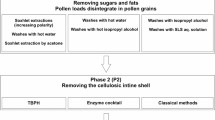Summary
During maturation of the pollen in species ofIberis (Cruciferae) materials from the anther tapetum are transferred to cavities of the exine. These sporophytically-derived materials are responsible for the rejection response induced in the stigmatic papillae within 4–6 h. following incompatible pollination, a response which leads to the occlusion of the stigma papillae by the polysaccharide, callose. The rejection reaction can be induced with agar or agarose gels into which pollen-wall materials have been allowed to diffuse, and also with isolated fragments of the tapetum itself taken from anthers of incompatible plants before transfer of its contents to the pollen. Partial fractionation of the exine-held materials using thin-layer gel filtration suggests that the incompatibility reactions are mediated by one or more “recognition” proteins or glycoproteins in a group with molecular weights in the range 10,000–25,000 daltons.
The rejection response has been found to be a rapid and sensitive assay for incompatibility in several Cruciferae.
Similar content being viewed by others
Literature
Arens, K.: Prova de calose por meio da microscopia a luz fluorescentia e applicacoes do metode. Lilloa18, 71–75 (1949).
Bateman, A. J.: Self-incompatibility systems in angiosperms, II.Iberis amara. Heredity8, 305–332 (1954).
Burnet, F. M.: Self recognition in colonial marine forms and flowering plants in relation to the evolution of immunity. Nature232, 230–234 (1971).
Dickinson, H. G., Lewis, D.: Cytochemical and ultrastructural differences between intraspecitic compatible and incompatible pollinations inRaphanus. Proc. Roy. Soc. Lond. B,183 12–38 (1973).
Frank, J. A., Paxton, J. D.: An inducer of soybean phytoalexin and its role in the resistance of soybeans toPhytophthora rot. Phytopathol.61, 954–958 (1971).
Heslop-Harrison, J.: Ribosome sites and S gene action. Nature Lond.,218, 90–91 (1967).
Heslop-Harrison, J.: Tapetal origin of pollen-coat substances inLilium. New Phytol.67, 779–786 (1968).
Heslop-Harrison, J., Heslop-Harrison, Y., Knox, R. B., Howlett, B.: Pollen-wall proteins: ‘Gametophytic’ and ‘Sporophytic’ fractions in the pollen walls of the Malvaceae. Ann. Bot.37, 403–412 (1973).
Howlett, B. J., Knox, R. B., Heslop-Harrison, J.: Pollen-wall proteins: release of a ragweed allergen — Antigen E — from pollen grains. J. Cell Sci. (1973, in press).
Knox, R. B.: Pollen-wall proteins: pollen-stigma interactions in ragweed andCosmos (Compositae). J. Cell Sci.12, 421–444 (1973).
Knox, R. B., Heslop-Harrison, J.: Pollenwall proteins; localisation and enzymic activity. J. Cell Sci.6, 1–27 (1970).
Knox, R. B., Heslop-Harrison, J.: Pollen-wall proteins: fate of the intine-held antigens in compatible and incompatible pollination ofPhalaris tuberosa L. J. Cell Sci.9, 239–251 (1971a).
Knox, R. B., Heslop-Harrison, J.: Pollen-wall proteins: localisation of antigenic and allergenic proteins in the pollen-grain walls ofAmbrosia spp. (ragweeds). Cytobios4, 49–54 (1971b).
Knox, R. B., Willing, R., Ashford, A. E.: Role of pollen-wall proteins as recognition substances in interspecific incompatibility in poplars. Nature, Lond.,237, 381–383 (1972).
Knox, R. B., Willing, R., Pryor, L. D.: Interspecific hybridization in poplars using recognition pollen. Silvae Genetica (1972).
Kroh, M.: An electron-microscopic study of the behaviour ofCruciferae pollen after pollination. In: H. F. Linskens (ed.), Pollen Physiology and Fertilization, p. 221–224 (1964).
Linskens, H. F., Kroh, M.: Inkompatibilität der Phanerogamen. Encycl. Plant Physiology, Springer-Verlag,18, 506–530 (1967).
Nasrallah, M. E., Barber, J. T., Wallace, D. H.: Self incompatibility proteins in plants: detection, genetics and possible mode of action. Heredity24, 23–27 (1969).
Radola, B. J.: Thin-layer gel filtration of proteins. I. Methods. J. Chromatogr.38, 61–77 (1968).
Sampson, D. R.: Intergeneric pollen-stigma incompatibility in the Cruciferae. Can. J. Genetics & Cytol.4, 38–49 (1962).
Stryer, L.: Fluorescence spectroscopy of proteins. Science, N. Y.,162, 526–533 (1968).
Thompson, K. F.: Self-incompatibility in marrow-stem kale,Brassica oleracea var.acephala. I. Demonstration of sporophytic system. J. Genet.55, 45–60 (1957).
Thompson, K. F., Howard, H. W.: Self-incompatibility in marrow-stem kale,Brassica oleracea var.acephala. II. Methods for the recognition in inbred lines of plants homozygous for S alleles. J. Genet.56, 1–16 (1959).
Author information
Authors and Affiliations
Additional information
Communicated by R. Riley
On leave from Department of Botany, Australian National University, Canberra.
Rights and permissions
About this article
Cite this article
Heslop-Harrison, J., Knox, R.B. & Heslop-Harrison, Y. Pollen-wall proteins: Exine-held fractions associated with the incompatibility response in cruciferae. Theoret. Appl. Genetics 44, 133–137 (1974). https://doi.org/10.1007/BF02981926
Received:
Issue Date:
DOI: https://doi.org/10.1007/BF02981926




